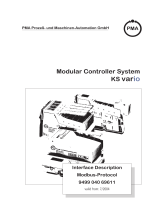
MVI56E-MCMR ♦ ControlLogix Platform Contents
Modbus Communication Module with Reduced Data Block User Manual
ProSoft Technology, Inc. Page 5 of 223
Contents
Your Feedback Please ........................................................................................................................ 2
How to Contact Us .............................................................................................................................. 2
ProSoft Technology
®
Product Documentation .................................................................................... 2
MVI (Multi Vendor Interface) Modules ................................................................................................ 3
Important Safety Information ............................................................................................................... 3
Battery Life Advisory ........................................................................................................................... 4
1 Start Here 9
1.1 What's New? ........................................................................................................... 10
1.2 System Requirements ............................................................................................. 11
1.3 Deployment Checklist .............................................................................................. 12
1.4 Package Contents ................................................................................................... 14
1.5 Setting Jumpers ...................................................................................................... 15
1.6 Installing the Module in the Rack ............................................................................ 16
1.7 Importing the Sample Add-On Instruction ............................................................... 18
1.7.1 About the Optional Add-On Instruction ................................................................... 18
1.8 Creating a New RSLogix 5000 Project .................................................................... 19
1.8.1 Creating the Remote Network ................................................................................. 20
1.8.2 Creating the Module in a Remote Rack .................................................................. 22
1.8.3 Creating the Module in a Local Rack ...................................................................... 25
1.8.4 Importing the Ladder Rung...................................................................................... 28
1.8.5 Adjusting the Input and Output Array Sizes ............................................................ 37
1.9 Connecting Your PC to the ControlLogix Processor ............................................... 40
1.10 Downloading the Sample Program to the Processor .............................................. 41
1.10.1 Configuring the RSLinx Driver for the PC COM Port .............................................. 42
2 Configuring the MVI56E-MCMR Module 45
2.1 Installing ProSoft Configuration Builder .................................................................. 45
2.2 Using ProSoft Configuration Builder Software ........................................................ 46
2.2.1 Upgrading from MVI56-MCMR in ProSoft Configuration Builder ............................ 46
2.2.2 Setting Up the Project ............................................................................................. 48
2.2.3 Setting Module Parameters ..................................................................................... 50
2.3 Configuration as a Modbus Master ......................................................................... 52
2.3.1 Overview.................................................................................................................. 52
2.3.2 Backplane Configuration ......................................................................................... 53
2.3.3 Port Configuration ................................................................................................... 54
2.3.4 Master Command Configuration ............................................................................. 57
2.3.5 Other Modbus Addressing Schemes ...................................................................... 61
2.3.6 Master Command Examples ................................................................................... 62
2.3.7 Floating-Point Data Handling (Modbus Master) ...................................................... 71
2.4 Configuration as a Modbus Slave ........................................................................... 78
2.4.1 Overview.................................................................................................................. 78
2.4.2 Configuration File Settings ...................................................................................... 78
2.4.3 Slave Configuration ................................................................................................. 83
2.4.4 Floating-Point Data Handling (Modbus Slave) ........................................................ 84
2.5 Ethernet Configuration ............................................................................................ 87
2.6 Connecting Your PC to the Module's Ethernet Port ................................................ 88
2.6.1 Setting Up a Temporary IP Address ....................................................................... 88



























